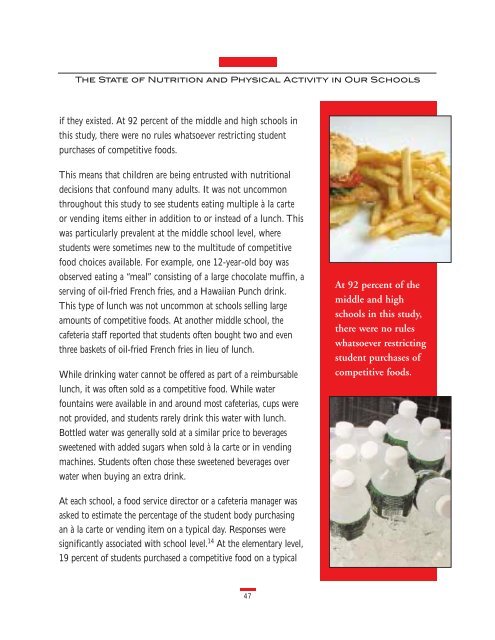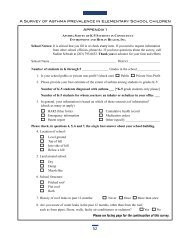nutrition and physical activity in our schools - Environment & Human ...
nutrition and physical activity in our schools - Environment & Human ...
nutrition and physical activity in our schools - Environment & Human ...
- No tags were found...
Create successful ePaper yourself
Turn your PDF publications into a flip-book with our unique Google optimized e-Paper software.
The State of Nutrition <strong>and</strong> Physical Activity <strong>in</strong> Our Schoolsif they existed. At 92 percent of the middle <strong>and</strong> high <strong>schools</strong> <strong>in</strong>this study, there were no rules whatsoever restrict<strong>in</strong>g studentpurchases of competitive foods.This means that children are be<strong>in</strong>g entrusted with <strong>nutrition</strong>aldecisions that confound many adults. It was not uncommonthroughout this study to see students eat<strong>in</strong>g multiple à la carteor vend<strong>in</strong>g items either <strong>in</strong> addition to or <strong>in</strong>stead of a lunch. Thiswas particularly prevalent at the middle school level, wherestudents were sometimes new to the multitude of competitivefood choices available. For example, one 12-year-old boy wasobserved eat<strong>in</strong>g a “meal” consist<strong>in</strong>g of a large chocolate muff<strong>in</strong>, aserv<strong>in</strong>g of oil-fried French fries, <strong>and</strong> a Hawaiian Punch dr<strong>in</strong>k.This type of lunch was not uncommon at <strong>schools</strong> sell<strong>in</strong>g largeamounts of competitive foods. At another middle school, thecafeteria staff reported that students often bought two <strong>and</strong> eventhree baskets of oil-fried French fries <strong>in</strong> lieu of lunch.While dr<strong>in</strong>k<strong>in</strong>g water cannot be offered as part of a reimbursablelunch, it was often sold as a competitive food. While waterfounta<strong>in</strong>s were available <strong>in</strong> <strong>and</strong> around most cafeterias, cups werenot provided, <strong>and</strong> students rarely dr<strong>in</strong>k this water with lunch.Bottled water was generally sold at a similar price to beveragessweetened with added sugars when sold à la carte or <strong>in</strong> vend<strong>in</strong>gmach<strong>in</strong>es. Students often chose these sweetened beverages overwater when buy<strong>in</strong>g an extra dr<strong>in</strong>k.At 92 percent of themiddle <strong>and</strong> high<strong>schools</strong> <strong>in</strong> this study,there were no ruleswhatsoever restrict<strong>in</strong>gstudent purchases ofcompetitive foods.At each school, a food service director or a cafeteria manager wasasked to estimate the percentage of the student body purchas<strong>in</strong>gan à la carte or vend<strong>in</strong>g item on a typical day. Responses weresignificantly associated with school level. 14 At the elementary level,19 percent of students purchased a competitive food on a typical47







